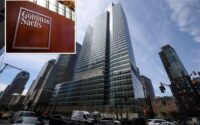Fed holds interest rates steady, another hike this year possible
Federal Reserve officials held interest rates steady on Wednesday after two days of debate on the highly anticipated decision — but signaled that another hike before year’s end remains on the table.
The unanimous decision to keep the benchmark federal funds rate at its current 22-year high, between 5.25% and 5.5%, marks the second pause in the six policy meetings the Fed has had so far this year.
“The US banking system is sound and resilient,” the Fed said Wednesday in a statement that was minimally changed from July.
The Fed noted that the economy has been expanding at a “solid” pace — an update from a “moderate” pace.
During Fed Chair Jerome’s Powell closely watched press conference following the central bank’s release, he reaffirmed that “the process of getting inflation sustainably down to 2% has a long way to go.”
Powell pointed to the Fed’s economic projections, which suggest that the Fed could reach its goal by the fourth quarter of 2026.
In order to do so, Powell said, the Fed is “prepared to raise rates further, if appropriate,” suggesting that more rate hikes could be imminent.
Twelve Fed officials said at the latest meeting that they would support one more rate hike before the end of 2023, while seven would prefer to maintain the policy stance, Powell said.
After trading in positive territory for most of the day, stocks slumped in the wake of announcement. The Dow slipped 76 points, or 0.2%, while the Nasdaq and S&P 500 tumbled 1.5% and 0.9%, respectively.

“It’s your standard Fed day volatility,” said Ryan Detrick, chief market strategist at Carson Group told Reuters. “Yet it wasn’t really a curve-ball event, because markets took things in stride.”
Economists are forecasting rates to peak between 5.5% and 5.75% by year’s end, which would mark one more quarter-point rise.
“We are far from the recession many have predicted. We are closer to a soft landing,” said Gina Bolvin, the president of Bolvin Wealth Management Group.
JJ Kinahan, chief executive at IG Group North America, said: “If there is one thing that could potentially persuade the Fed to raise rates later this year, it’s oil.”
As Powell has recently made clear — and reiterated on Wednesday — central bankers are awaiting more data in order to understand how its latest July hike is affecting the US economy, which saw inflation rise a hotter-than-expected 3.7% in August.
Meanwhile, the Fed’s aggressive tightening regime has worked in slowly bringing down stubbornly high inflation from its 9.1% peak last June, though it still remains well above the central bank’s 2% goal.
Despite the economic slowdown spurred by July’s 25-basis-point hike, recent surveys have revealed that American consumers are still feeling squeezed by the economy.
A CNBC-Morning Consult survey published on Wednesday polled 4,403 US adults last week, and found that 55% of lower-income households earnings less than $50,000 annually and 61% of middle-income earners bringing in $50,000 to $100,000 are suffering from the state of the economy.
Even among the highest earners with annual incomes exceeding $100,000, 46% said they’re feeling the impact of the economy on their finances.
Because of this, it comes as no surprise that more than three-quarters of respondents, 76%, plan to cut back spending on non-essential items over the next six months, during retailers’ all-important holiday shopping season, while 62% said they plan on budgeting “sometimes” or “more often” in the upcoming months, CNBC found.
Another survey conducted by Bloomberg concluded that most Americans believe consumer spending — the most important driver of the US economy — is expected to shrink in early 2024, marking the first quarterly decline since the start of the pandemic.
More than half of 526 respondents, or 56%, believe that personal consumption in the US will turn negative in the new year, Bloomberg found in its latest Markets Live Plus survey published last week.

Another 21% said the reversal will happen even sooner, in the final quarter of 2023, Bloomberg found, citing pessimism about the housing market and COVID-era savings drying out.
Despite a cooling housing market, mortgage rates remain sky-high — at a level not seen since 2001 — and forcing many homeowners in major US cities to sell at a loss.
To make matters worse, so far this year, credit card delinquencies have reached new heights, hitting 3.8% for the first time since the financial crisis.
Meanwhile, 3.6% of inflation-squeezed Americans have defaulted on their car loans, according to credit agency Equifax.
Both figures are the highest in more than 10 years.
The data come on the heels of inflation rising more than expected in August, when the Consumer Price Index showed that last month’s advance was a surprisingly stiff 0.6% in August versus a month earlier, according to data by the Bureau of Labor Statistics released last week.
The rise was attributed to soaring gasoline costs, which ticked 10.6% higher in August and accounted for over half of the increase, the data showed.
The energy index rose 5.6% in August after increasing just 0.2% in July.

Meanwhile, core CPI — which excludes volatile food and energy prices — rose 0.3% from a month ago, slightly more than the 0.2% monthly gain in June and July.
Shelter costs were the main culprit in the core CPI’s advance, the Bureau of Labor Statistics said.
Meanwhile, the labor market has shown surprising resiliency over the last couple of months.
It was only recently that employers have begun to slow hiring, though the US is enjoying a 31-month streak of monthly job gains.


